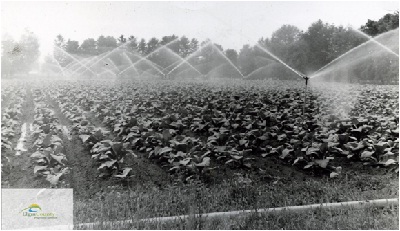In the Field

Irrigating an unidentified tobacco field near West Lorne in July 1966.
West Lorne Sun and Rodney Mercury fonds, C9 Sh6 B1 F1966 25.
Mid-June to Mid-August
The soil around the plants must be kept loose so it will drain well and be easily warmed by the sun, encouraging growth. Tobacco rows must be weeded by hand or mechanical means. As tobacco plants grow larger, they require a good deal of moisture, which must be supplied by irrigation if there is not enough rainfall.
When the plant has developed all its leaves, it begins to grow seed flowers on top, which must be removed along with some of the topmost leaves to direct all growth into the tobacco leaves below. The process is called topping and must be done carefully, leaving approximately 14-20 leaves on the plant to mature. Topping too low and leaving too few leaves results in large, poor-quality leaf while topping too high and leaving too many leaves causes the remaining leaves to be small and thin, also of poor-quality.
Once topping has been done, the plant will start to send out a new growth at the base of each remaining leaf, called a sucker, which will grow into a large shoot, and impede the healthy growth of the plant and cause the leaves to become thin if not removed. The process of removing these growths is called suckering. Suckering may be done by hand (and needs to be redone several times) or by placing a special oil and water mixture on the top of the plant immediately after topping, which runs down to the stalk to surround the emerging sucker and prevent further growth.
Tobacco in
Elgin County :
Production :
- Preparation
- Transplanting
- In The Field
- Harvest
- Into the Kiln
- Flue-Curing
- Baling
- Crop Damage
- The Workers